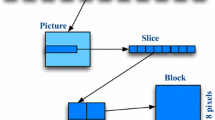Abstract
Owing to the recent development in mobile network technologies, users may enjoy streaming media services anytime, anywhere using personal mobile communication devices. Wireless mobile streaming media services, however, have such problems as delay, congestion, and crosstalk due to narrow network bandwidth and limited resources. These problems degrade not only Quality of Service (QoS), but also responsiveness and reliability of the streaming media service. To solve this problem, this paper proposes a Fuzzy Similarity-Based Transcoding Proxy (FSTP) mechanism. The proposed FSTP mechanism analyzes the fuzzy similarity of partitioned segment versions of media objects to construct a Fuzzy Similarity-Based Transcoding Graph (FSTG). The constructed FSTG determines transcoding for the partitioned media object segment versions. The determined transcoding improves Delay Saving Ratios (DSR), Cache Hit Precision Ratio (CHPR), and Cache Hit Recall Ratio (CHRR). Therefore, the more relevant media object segment versions, determined by the fuzzy similarity, are transcoded and cached first to reduce the start delay time and network traffic. The proposed mechanism is simulated to evaluate various performance parameters. The simulation results show that the proposed mechanism achieves improved performance in DSR, CHPR, and CHRR compared with those of other existing mechanisms.









Similar content being viewed by others
References
Chang C, Chen MS (2003) On exploring aggregate effect for efficient cache replacement in transcoding proxies. IEEE Trans Parallel Distrib Syst 14(6):611–624
Kao CF, Lee CN (2007) Aggregate profit-based caching replacement algorithms for streaming media transcoding proxy systems. IEEE Trans Multimed 9(2):221–230
Chen S, Shen B, Wee S, Zhang X (2006) Segment-based streaming media proxy: modeling and optimization. IEEE Trans Multimed 8(2):243–256
Chang KC, Chen TF (2007) Efficient segment-based video transcoding proxy for mobile multimedia services. J Syst Archit 53:833–845
Miao Z, Ortega A (1999) Proxy caching for efficient video services over the Internet. In: Packet video workshop, pp 1–21
Wu D, Hou YT, Zhou W, Zhang YQ, Peha JM (2001) Streaming video over the Internet: approaches and directions. IEEE Trans Circuits Syst Video Technol 11(3):282–300
Acharya S, Korth H, Poosala V (1999) Systematic multiresolution and its application to the World Wide Web. In: IEEE ICDE’99, Sydney, Australia, pp 40–49
Maheshwari A, Sharma A, Ramamrithan K, Shenoy P (2002) Transquid: transcoding and caching proxy for heterogeneous e-commerce environments. In: Proc IEEE INFOCOM 2002, San Jose, CA, pp 50–59
Li D, Chuah CN, Cheung G, Yoo Sj (2005) MUVIS: Multi-source video streaming service over WLANs. J Commun Netw 7:144–156
Mohan R, Smith JR, Li CS (1999) Adapting multimedia Internet content for universal access. IEEE Trans Multimed 1(1):104–114
Lee CD (2009) Proxy caching grouping by partition and mapping for distributed multimedia streaming service. Korean Inst Intel Syst 19(1):40–47
Lee CD, Jeong TW, Ahn JY (2009) A streaming service based on partition and mapping of media block. In: ISME2009, 6th international symposium on management engineering, 5–7 August, Dalian, China, CD, pp 1–6.
Cardelli V, Yu P, Sand Huang YW (2000) Collaborative proxy system for distributed web content transcoding. In: Proc ACM int’l conf information and knowledge management, pp 520–527
Prangl M, Kofler I, Hellwagner H (2008) Towards QoS improvements of TCP-based media delivery. In: Fourth international conference on networking and services, pp 188–193
Prangl M, Szkaliczki T, Hellwagner H (2007) A framework for utility-based multimedia adaptation. IEEE Trans Circuits Syst Video Technol 17(6):719–728
Jiang W, Li H, Jin H, Liao X (2009) Service guarantee for inter-domain movement in wireless peer-to-peer live streaming system. In: 2009 10th international symposium on pervasive systems, algorithms, and networks, pp 533–538
Kim K, Lee H, Chung K (2001) A distributed proxy server system for wireless mobile web service. In: 15th international conference on information networking (ICOIN’01), Beppu City, Oita, Japan, pp 749–754
Qin M, Zimmermann R (2010) An adaptive strategy for mobile ad hoc media streaming. IEEE Trans Multimed 12(4):317–329
Qin M, Zimmermann R (2007) Supporting guaranteed continuous media streaming performance through adaptive layer selection with scalable video coding. In: Proc 15th Annu ACM International Conference on Multimedia, pp 23–29
Wu KL, Yu S, Wolf JL (2004) Segmentation of multimedia streams for proxy caching. IEEE Trans Multimed 6(5):770–780
Wang JZ, Yu PS (2007) Fragmental proxy caching for streaming multimedia objects. IEEE Trans Multimed 9(1):147–156
Park YH, Lee YJ, Kim HY, Kim KS (2008) Hybrid segmented-based transcoding proxy caching of multimedia streams. In: IEEE 8th international conference on computer and information technology workshops, pp 319–324
Hsu TH, Li YH (2009) A dynamic cache scheme for multimedia streams on heterogeneous networking environments. In: 3rd international conference on multimedia and ubiquitous engineering 2009, pp 91–98
Ma W, Du DHC (2004) Design a progressive video caching policy for video proxy server. IEEE Trans Multimed 6(4):599–610
Shen B, Lee SJ, Basu S (2004) Caching strategies in transcoding-enabled proxy systems for streaming media distribution networks. IEEE Trans Multimed 6(2):375–386
Lee CD, Jeong TW (2010) Fuzzy filtering based segment grouping for user-centered multimedia streaming service in P2P distribution mobile networks. J Int Technol 11(5):651–658
Atanassov KT (1986) Intuitionistic fuzzy sets. Fuzzy Sets Syst 20:87–96
Breslau L, Cao P, Fan L, Phillips G, Shenker S (1999) Web caching and zipf-like distributions: evidence and implications. In: Proc IEEE INFOCOM, vol 1, pp 126–134
Acknowledgement
This paper was supported by research funds of Chonbuk National University in 2011.
Author information
Authors and Affiliations
Corresponding author
Rights and permissions
About this article
Cite this article
Lee, C. Streaming media service based on fuzzy similarity in wireless mobile networks. J Supercomput 65, 86–105 (2013). https://doi.org/10.1007/s11227-012-0778-6
Published:
Issue Date:
DOI: https://doi.org/10.1007/s11227-012-0778-6




